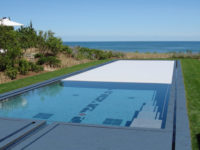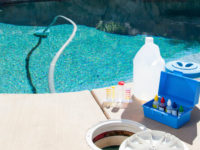The long-awaited purchase, installation, and startup of the pool are complete! Now you and your friends can enjoy swimming every day. However, the constant pool use accelerates the filters’, pumps’, covers’, and surface’s wear and tear. That is why one of the procedures you should be familiar with during maintenance is pool replastering.
If you use your pool for 5-10 years, you may notice some roughness on the surface. In addition to not aesthetical appealing, they may cause you discomfort. You may even get scratched or tear your clothes.
Of course, you’ll want to get rid of this problem as soon as possible. Therefore, in this article, we will tell you in detail about what pool replastering is, why and when it is worth it to replaster, how much it costs, how to do it, and what alternatives exist.
Let’s get started!
What Is a Pool Replastering?

When you build an in-ground pool, you probably use gunite or concrete to cast the mold. These materials cure and form a tight shell that will not get damaged over time.
However, gunite and concrete are porous. Due to them, water can leak into these pores, so you need to fill your pool periodically. That’s why you need to apply plaster to the surface. This material fills the pores, hardens, and prevents water from seeping in.
Replastering the pool works on the same principle. It is a process of applying a new layer of plaster. It needs to be renewed periodically as this material loses its strength and smoothness over time.
Why Is It Important To Replaster a Pool?

Replastering is one of the most important steps in the regular pool maintenance. There are three main reasons for doing it.
- Pool waterproofing. The main purpose of replastering is to prevent the pool shell from breaking down. Concrete and gunite are porous substances and when water gets inside, it causes cracks and leaks. Therefore, you need to apply a new layer of plaster that will close the pores and keep water out.
- Stains overlapping. Red and brown stains are caused by metals and rust in the water. They can get into the water through the pump or with garbage. Manganese, copper, or iron can be the cause of such stains. When in contact with water, they oxidize and stain the surface. Also, low pH increases the acidity of the water. It can begin to corrode the copper heater, which will also result in stains. You can plaster them over and forget about them for a long time.
- Surface smoothing. Over time, plaster begins to delaminate when exposed to water and the pool surface becomes rough and bumpy. Therefore, you need to replaster the pool’s walls and floor. This material fills in the space between the bumps and forms an even surface.
When You Can/Can’t Replaster Your Pool

We’ve already figured out why it’s necessary to replaster the pool walls and floor. However, before we find out how to do it, there are a few additional conditions you should follow.
The procedure must be done under certain weather conditions to make a plaster dry evenly, not crack, and not become ridged. Therefore, below we will explain in detail when and how often you should/shouldn’t replaster the pool.
When Is It Worth Replastering?
Plastering is most often done with a gypsum mixture. It dries in about 7 days, which is 4.3 times faster than cement-based plaster.
For your mixture to dry quickly and evenly, you need to follow the listed below rules:
- An air temperature of about 68°F (20°C);
- A humidity of no more than 70%.
Otherwise, the plastered coating may not dry evenly. It will cause the material to peel or crack.
When Is It Not Worth Replastering?
Failure to observe the temperature regime during resurfacing has negative consequences. The following is a description of the dangers that are based on the temperature when you replaster the pool.
- > 75°F (24°C). The plaster will dry too quickly. It will cause cracks to appear on the surface where water will penetrate.
- < 50°F (10°C). The plaster will take 2-3 times longer to dry than a normal temperature of about 68°F (20°C).
- < 32°F (0°C). Normal gypsum-based mortar will not dry but will freeze. When the temperature gets higher, the plaster layer will fall off. However, you can add about 1 cup of nitrate salt and soda per 260 gallons (1 cubic meter) of mortar. Then you can plaster even at 23°F (-5°C). The principle here is the same as with seawater: the salt and soda keep the material from freezing.
In addition to the temperature regime, it is necessary to pay attention to the presence of wind. It can bring small debris into the plaster, which will create irregularities on the surface.
How Often To Do It?
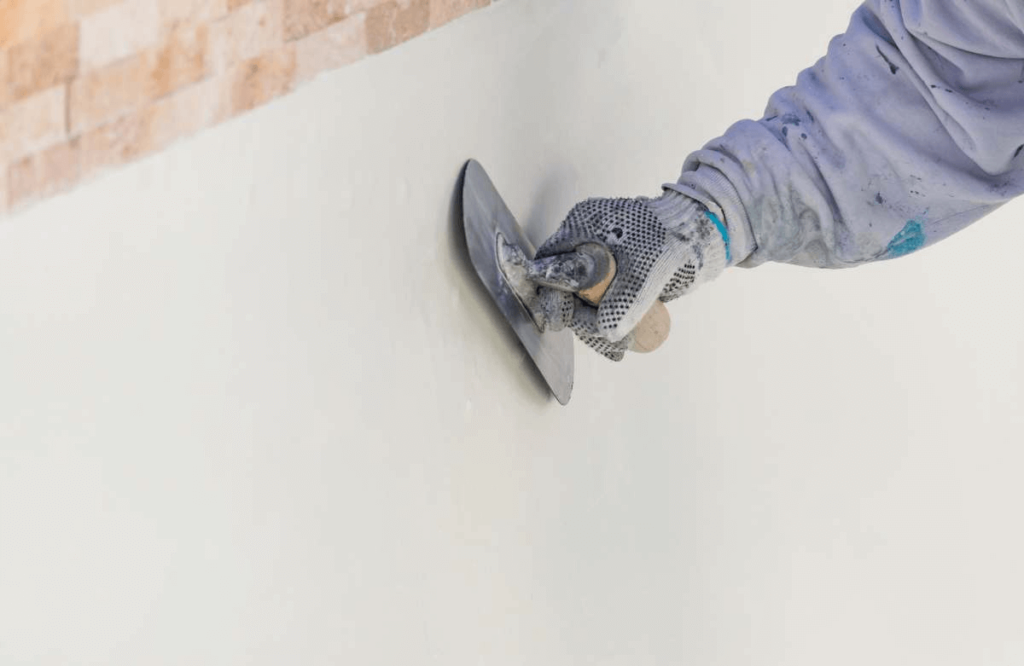
On average, you should have your pool replastered every 10 years. If there are many such imperfections on the surface, the procedure should be carried out symptomatically:
- Cracks in the plaster;
- Red and brown stains from metal oxidation;
- Roughness or bumps on the surface.
4 Easy Steps On How To Replaster A Pool

The process of replastering is time-consuming. It can be divided into four steps:
- Preparing the pool;
- Removing the old plaster;
- Applying the first layer;
- Applying the finishing layer.
Next, we have gathered together a step-by-step plan with explanations for you to learn all the ins and outs.
Pool Surface Preparation
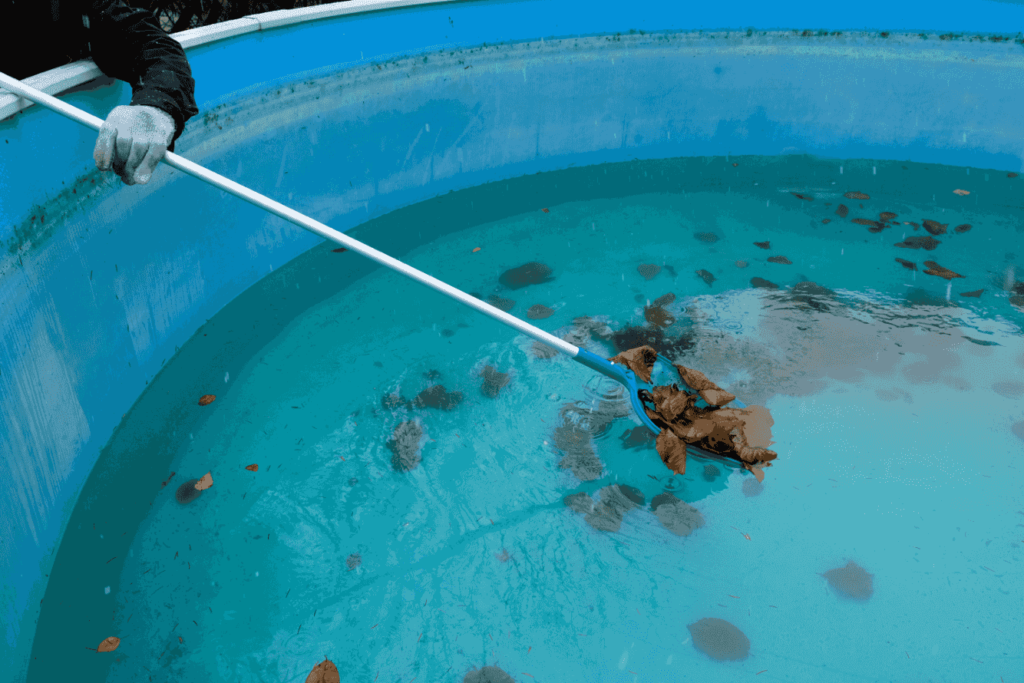
The first thing you should do is turn off all pool equipment, including pumps and heaters. After that, you can begin to dry the pool. Drain the water, pump out the residue with a sump pump and allow the surface to dry. Otherwise, the plaster will not dry evenly on the wet surface and may come off over time.
After that, you need to get rid of all the debris and dirt on the pool surface. If you put a plaster on it, it will create unevenness. Also, you should remove the plastering pieces that break off and sand away the irregularities that form where the chips are. Most importantly, do not forget to remove the dust that remains after sanding. It can also cause the plastering to fall off.
Removing The Old Plaster

You can use a paint remover to clear a layer of old plastering. It contains a solvent that softens the material. You should apply it with a brush or roller and wait about 15-20 minutes.
Next, start removing the plastering with a scraper. If you can’t clear the entire layer, reapply the paint remover to the surface and repeat the process until you have removed all of it.
Afterward, you will need to rinse the pool thoroughly so that no chemicals remain on the surface. They may prevent the new layer of plastering from sticking to the pool shell.
Applying Basic Plastering

Basic plastering is used to level surfaces and remove roughness. Most often, you can purchase it in dry form. Then, you should prepare a mixture from it. It is not difficult to do, because on each package there are detailed instructions.
You will need to take a trowel and apply plastering to the entire surface of the pool. The layer should be a thickness of 0.375″ (3/8″). Also, to avoid difficulties, start plastering the areas farther away from your pool ladder and shift toward it. In this case, you will be able to get out and not have to walk over the plastering. Afterward, wait about a week to finally dry the surface.
Applying Finishing Plastering

After the base coat dries, it is necessary to apply the finishing plaster. It is used to prevent mold and increase water resistance. Another feature of the finishing coat is that it should be applied in a thin layer. It does not level the surface but simply strengthens its protective properties. Therefore, a thick layer is not necessary.
As for your pool, you will need to make a layer 0.25″ (1/4″) thick. After application, also dry it for about a week. Then you can paint the surface or lay tiles. It’s up to you.
How Much Does It Cost?

Calculating the exact cost of a pool replastering is difficult for two reasons.
- The pool condition. For example, if you have a dirty pool with green water, you will need to spend more money to clean it.
- Plastering crew cost. The cost of services will vary from state to state.
However, we have calculated the approximate cost of replastering with and without crew services in different US cities for a 100-square-foot pool.
| Cost/City | New-York | Los Angeles | Miami |
| Cost of materials | $171 per 100 feet | $164 per 100 feet | $157 per 100 feet |
| The cost of a work crew | $592 | $462 | $361 |
| Total | $763 or $7.63 for 1 feet | $626 or $6.26 for 1 feet | $518 or $5.81 for 1 feet |
| Total excluding crews | $171 or $1.71 for 1 feet | $164 or $1.64 for 1 feet | $157 or $1.57 for 1 fett |
However, not everyone can afford to hire a crew. Therefore, below we list the approximate cost of the materials and tools starter pack.
| Materials or tools | Approximate cost |
| Plaster remover | $22 for 32 oz. |
| Brush for plaster remover | $6 |
| Multi-Purpose Cleaner Kit | $18 |
| Pool plaster | $145 for 54 lb. |
| Putty knife | $6 |
| Drill mixer set with paddle | $90 |
| Total: | $287 |
Is it Possible To Save Money And To Plaster Over Old Plaster?
You can put new plaster on top of the old plaster. However, if the surface is rough and has cracks, you will have to make some preparations. First, you need to fill small cracks with sealant. Second, the larger ones should be taped over with mesh and covered with plaster.
Not everyone can cope with this work. Also, you may need the help of a repair team. If not to go into the exact calculations, you can save some money when the old plaster is almost undamaged.
This option is worth considering when it is time to replaster and the surface is not seriously damaged.
Pool Replastering Alternatives
What are some alternatives to plastering as a type of in-ground pool finish? The answer is very simple. It could be paint or tile. However, people are increasingly choosing to plaster, so let’s understand why and find out the pros and cons of other finishes.
Paint
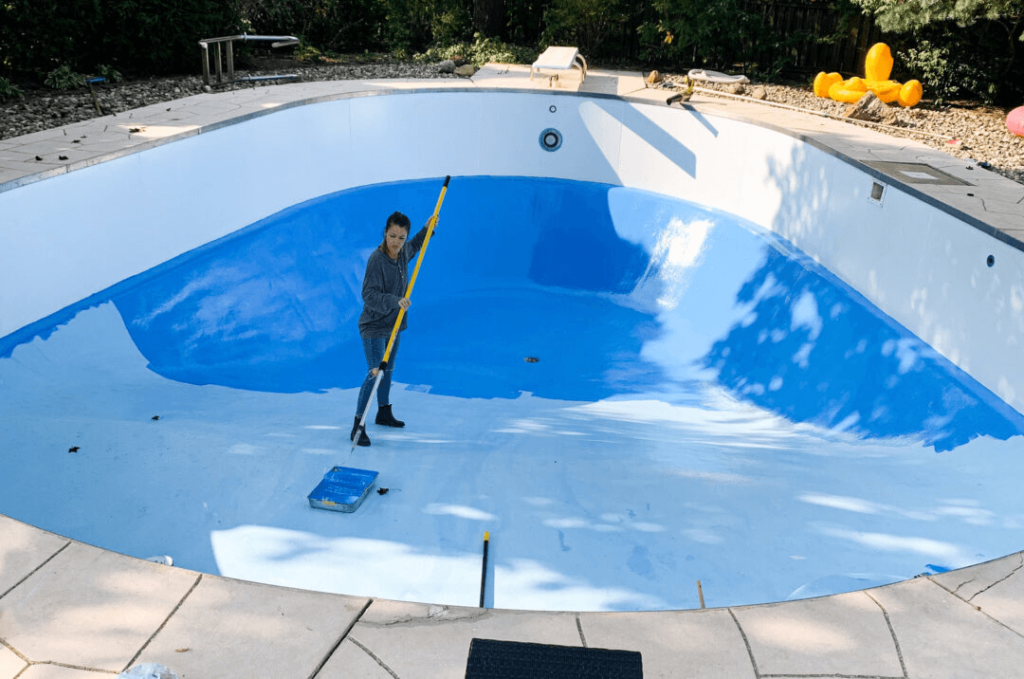
Previously, the finishing of swimming pools used mostly special paint, which can also withstand constant moisture. Also, for example, the cost of materials to paint a 100-foot square pool in New York City will cost $97. That’s 1.66 times cheaper than replastering ($171).
However, this type of finish has a significant disadvantage – durability. You will have to repaint the surface 2.5-5 times more often than plastering, i.e. every 2-4 years. So, as a one-time measure, it’s a great solution, but in the long run, plastering is more durable and better financially ($242.5-$485 for paint versus $171 for plastering).
Tile

It can be laid once and will last for decades. It is a definite advantage. You just need to wash it, watch the seams, and not to damage the tiles so you don’t have to replace them. However, the pool owner will have to allocate a large sum of money at one time. The cost to install 1 square foot of tile ranges from $75 to $100. That’s 44 to 58 times more expensive than plastering!
To summarize, if you have enough money, it’s better to splurge once and tile your pool because it will last longer and look better. Otherwise, it is better to plaster the pool.
Summary
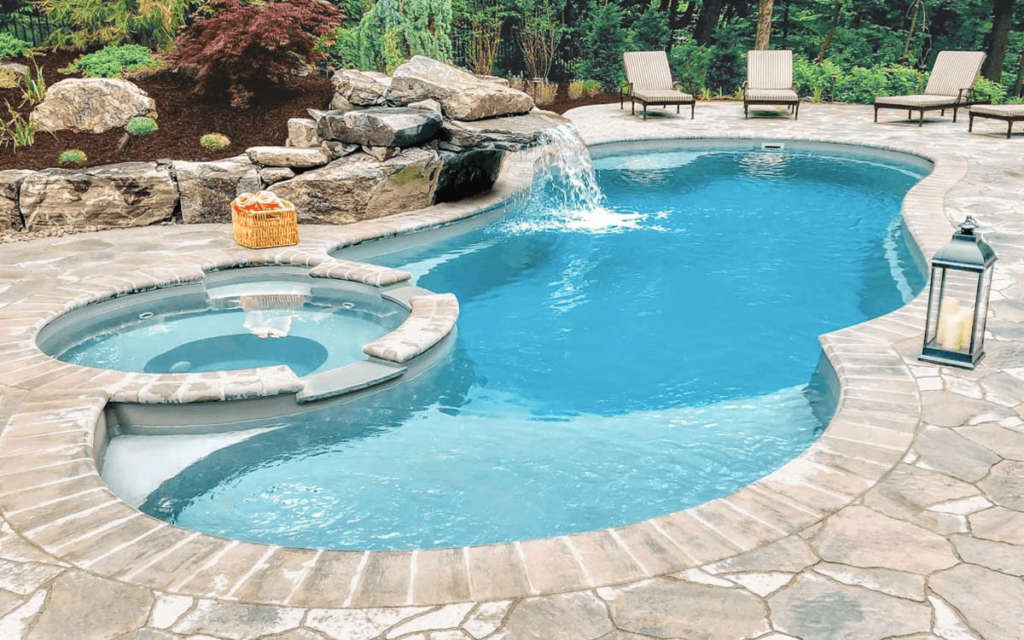
So, we’ve analyzed all of these aspects, looked at the most popular questions on the topic, and talked about what pool replastering is, why it’s important, how to do it, how much it costs, and whether there are alternatives.
Replastering a pool is a time-consuming process. You can do it yourself or with the help of professionals who will do everything for you. Also, the replastering process has some differences from the original surface finish.
FAQ
🆚 What is the difference between plastering a pool and resurfacing a pool?
Pool replastering and resurfacing are used to fill cracks, level out irregularities, and remove stains on the pool surface. The only difference is that pool replastering uses a mixture based on gypsum and resurfacing on concrete.
❓ Is it possible to plaster a pool without removing the tiles?
No, because the tiles are laid on plaster. You have to take it off so that you can replaster the surface.
🌧 Is it okay to replaster a pool when it rains?
Rain on soft plaster will cause streaks. Therefore, the surface will be uneven.
🌡 At what temperature is it worth replastering a pool?
The best temperature for replastering is 68°F (20°C), but you can run the process from 50°F (10°C) to 75°F (24°C).
🤔 Can I Plaster a Pool on My Own?
You can replaster the pool yourself, but the surface may not be as smooth and even because it is a time-consuming process that requires special skills.


